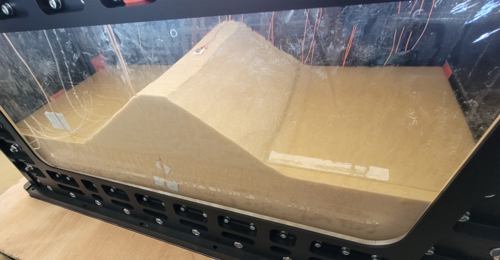Access the Recherche DATA Gouv repository
How do embankments stand up against earthquakes?
Chedid Saade, post-doctoral fellow at the CG, Gustave Eiffel University
Chedid Saade, a postdoctoral researcher at the Geotechnical Centrifuge laboratory, defended his thesis at the end of 2023. His work sheds light on the behaviour of an embankment such as a dyke during earthquake, particularly following ground liquefaction. He shares his findings with the scientific and professional seismic risk community.
“My thesis looked at the behaviour of soils under seismic events,” explains Chedid Saade. “Earthquakes can induce a phenomenon known as liquefaction: as a result of high pore pressures, the ground undergoes a sudden loss of resistance and, to put it very simply, begins to behave like a fluid.” This phenomenon is a major cause of disaster during earthquakes, resulting in landslides and soil settlement. When the ground is temporarily “transformed” into fluid, it causes the collapse of homes and infrastructure and the failure of embankments and dams. This particularly deadly phenomenon has been witnessed during earthquakes in Japan and Indonesia, and during the 7.8 magnitude earthquake that struck Turkey in 2023.
Scale models put to the test in the geotechnical centrifuge
Chedid Saade’s thesis was divided into several stages. The first experimental phase took place at the Geotechnical Centrifuge (CG) laboratory at the university’s campus in Nantes. Objective: to study the behaviour of an embankment on liquefiable ground as part of a series of tests on 1/N scale models. “The small-scale models of embankments used in these tests were 10 cm high, with a ground layer 15 cm thick and a crest width of 5 cm, representing a 6-metre-high embankment built on a 9-metre layer at prototype scale. These tests required no less than 120 kilos of sand and fine particles and several days of preparation,” explains the young researcher.
The scale models, equipped with different types of sensors, were installed in the shaker, a shaking table embedded in the university’s geotechnical centrifuge, which is one of the largest in the world. This device makes it possible to apply time sequences of controlled acceleration, in other words vibrations that replicate the conditions of an earthquake. e de l’université, l’une des plus grandes au monde. Ce dispositif permet d’appliquer des séquences temporelles d'accélération contrôlée, autrement dit des vibrations qui recréent les conditions d’un séisme. “This is a great opportunity for young researchers to have access to scientific equipment of this kind, which is remarkable for its size and cutting-edge technology,” says Zheng Li, the researcher who co-supervised Chedid Saade’s thesis..

Open source research for better earthquake prevention
In this research, co-funded by the Pays de la Loire Region, a numerical study of the behaviour of embankments was also conducted. It has provided several insights: the phenomenon of ground liquefaction occurs below the free surface of the ground and not below the embankment. Another key insight is the potential settlement of the embankment under seismic excitation. This settlement occurs at the crest and is accompanied by lateral displacement at the base. The research also showed that the presence of non-plastic fines in the soil increases its resistance and reduces the intensity of liquefaction.
Chedid Saade was keen to make these results available as open source: “My research work and the data I have collected are intended to be shared with researchers around the world, and particularly with seismic risk professionals. In particular, countries that are severely affected by earthquakes, such as Italy, China and Japan, could benefit from this experiment.”
Glossary
Ground liquefaction: seismic phenomenon in which the ground behaves like a liquid. This phenomenon is greatly feared due to the significant damage it causes and is the source of numerous infrastructure collapses during earthquakes.
Seismic risk: estimate of the destructive effect that an earthquake could have on a region. It takes into account the seismic hazard (the probability of an earthquake occurring in a given area during a given period) and the vulnerability of the infrastructure and population of the region in question.
Identity card of code
Access to code: | https://doi.org/10.57745/LDNZR9 |
License: | etalab 2.0 |
Production date: | 2023-05-26 |
Citations: | Saade, Chedid; Li, Zheng; Escoffier, Sandra; Thorel, Luc, 2023, "Centrifuge data of a homogeneous embankment model resting on liquefiable soil subjected to a strong dynamic excitation - Experimental Database", https://doi.org/10.57745/LDNZR9, Recherche Data Gouv, V2 |
Contact: | Chedid Saade, post-doctoral fellow at the CG |
Key Words: | Centrifuged model; Dyke; Embankment; Ground liquefaction; Centrifuge; |

![[Translate to English:] Licence creative commons BY-SA 4.0 [Translate to English:] Licence creative commons BY-SA 4.0](https://reflexscience.univ-gustave-eiffel.fr/fileadmin/ReflexScience/Accueil/Logos/CCbySA.png)